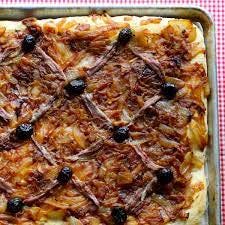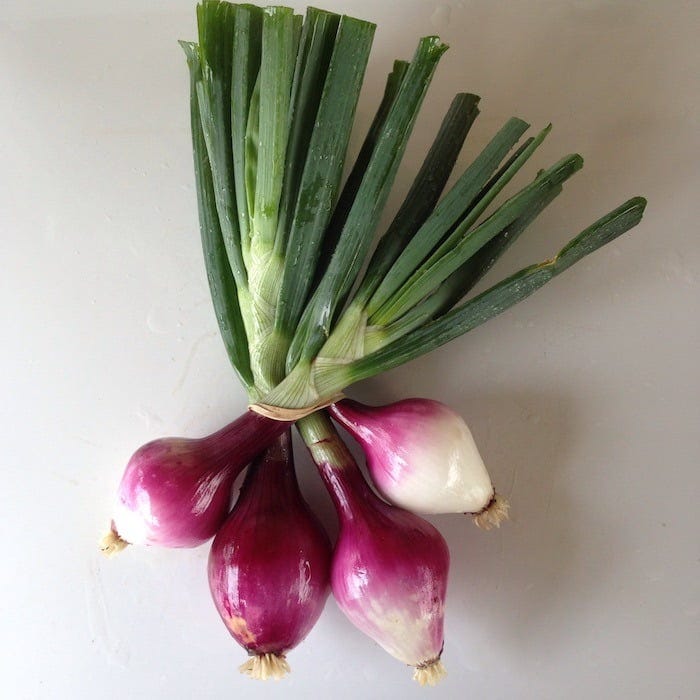I have moved from being a loather of raw onions to finding any recipe excuse to pile them on. (If you invite me out, I promise to desist from raw onion consumption 24 hours beforehand.)
I’m not quite sure how it crept up on me, except it is not related to regular tear-inducing yellow or red onions but exposure to scallions - or spring onions as we know them in the UK. They never used to get so much space in supermarkets but under Ottolenghi’s influence now do. Recently, I’ve found myself buying 3-for-the-price-of-2 bunches of them about twice a week. Middle East markets sell them as plump as plums.
Brush with a little oil then set on a griddle that you’ve heated to seering-hot, and once they’ve acquired their stripes, lower it to allow the onions to soften. These pair well with skewers of marinated chicken chunks or shrimp.
I’ve written about onions before, so won’t go into their history, or mine with them. Part of my new obsession with scallions arises from having learned how to slice them the most seductively - very finely, at the deepest angle you can manage without including shaved fingernail. Ignore internet-reel lessons that instruct you to sliver scallions into jolly roundels that look like washers from a builders’ supply store. No. They need to end up thin and angular so that each individual layer rubbed gently apart between thumb and forefinger almost curls away from its neighbour with relief. Dispersed through a salad, they are barely identifiable. Yet they elevate not just overall flavour but texture. Scatter a generous handful of scallion shards over chunks of pumpkin that have been tossed in an emulsion of oil, salt, pepper and maple syrup then roasted and you elevate the pulpy squash from convalescent food for someone with tooth problems to restaurant-worthy.
Thinly slice a standard red or yellow onion then soak it in several changes of iced water and a startling measure of its astringency is removed. Sauté an onion or shallot, thinly sliced or left whole if small, in oil and butter over a low flame for a long period, stirring gently every so often. Once the onion has softened, season it with salt and pepper, fold in fresh thyme leaves, a tablespoon of sugar, two of vinegar, and it will end up jammy and sticky, its sweetness now emphasised. You’ve made the perfect side dish for a roast. Load some onto a thick slice of toasted brown bread, drape with a fillet of anchovy and you have a take-off of Pissaladière for a light Sunday supper.
If the smell left behind on your fingers after slicing onions concerns you, there’s no need to invest in one of those pricey stainless steel lozenges for sale in posh kitchen shops. Just think about how much stainless steel you already have in your kitchen - spoons, lids, handles - and rub your fingers on those before washing them.
Onions left whole are re-emerging to receive again the respect they’re due as a vegetable rather than mere flavouring. Supermarkets have cottoned on recently to the wide choice provided by the allium family. We’re familiar with shallots and those small pickling or pearl onions that are such a menace to peel. But suddenly you can buy baby red onions more mellow than their adult counterparts, wonderful both cooked or raw.
Cipollini onions are sweet, with more sugar than white or yellow onions, though not as much as shallots. Small and flat, their shape makes them good for an agrodolce (Italian for ‘sour-sweet’), a treatment also profitably applied to carrots or red peppers - celery stalks, even. Cooked this way, vegetables go well alongside a roast chicken drizzled with remaining sauce.
Stew cipollini, shallots or baby red onions gently over low heat with a little finely chopped garlic, a small glass of dry sherry or white wine, another of vinegar, and a couple of tablespoons of well-flavoured honey, lidded at first until they have softened, then uncovered to caramelise them a little.
Sweet-and-sour is commonly associated with gloopy red sauces in Chinese all-you-can-eat buffets dishes. But it’s a method that has a long and honourable history in China. A menu from 708 AD of food served at festivals during the Tang Dynasty (618-907 AD) includes a list of popular sweet-and-sour dishes. They are attributed to Chancellor Wei Juyuan as created by him and served to Emperor Zhongzong of Tang at a dinner he hosted for him at his house.
Cooking with vinegar and sugar arrived in England in the Middle Ages with Arab expansion into Europe via Spain. Recipes for sweet and sour meat and fish appear in the 1390 cookery book, The Forme of Cury.
Current interest in food from the wider Middle East along with efforts to cut down meat consumption has focused interest on vegetables as the centrepiece of a meal. This dish combines aubergine/eggplant with small whole onions and preserved lemons to produce a sticky dish to serve alone or with rice or warm flat breads. I haven’t specified quantities - you can elevate the amount of the vegetable you prefer. I tend to buy equal weights of aubergine and onions. It improves made the day ahead to mellow then served at room temperature.
1 large aubergine/eggplant, in 0.65cm/¼ in slices
4 tablespoons olive oil
250g/8oz small onions (cipollini or pearl or other) peeled
2 cloves garlic, peeled and roughly chopped
1 preserved lemon, roughly chopped
1 tablespoon coriander seeds, toasted
Salt the slices of aubergine for 30 minutes to release their juice. Run them under the tap then dry them thoroughly.
Heat the olive oil in a large saute pan over gentle heat then add the onions. Cover with a lid and simmer till soft.
Add the aubergine slices, garlic, lemon and coriander seeds. Season to taste with salt and a generous amount of black pepper. Slowly fry the aubergine slices on both sides till soft, adding more olive oil if necessary, but some should release back into the pan as the slices cook.
Serve at room temperature or cold.










Hi Julia. I followed this recipe and the result was delicious! Thank you. My only quibble - I feel it should have a name...? All the best. Adam
Oh Hello Julia! We're onion lovers here too. This last year, we grew four varieties (in No Florida) and one is the new winner. Tropea. Amazingly easy to grow. And grow. And GROW. They love to grow! HA! Unfussy and soooooo delicious. They have a unique flavor. Mild and clean, but still, clearly onion. They are long and red and keep very well even in this ungodly hot humid place. Oh, the relish. mmm